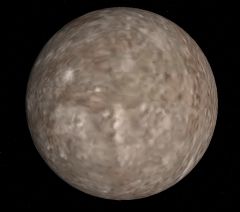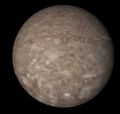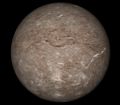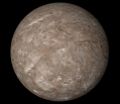Difference between revisions of "Titania"
(fixed typo, borrowed text) |
(Added content.) |
||
| (10 intermediate revisions by 3 users not shown) | |||
| Line 1: | Line 1: | ||
| − | '''Titania''' | + | {| cellpadding="2" cellspacing="0" style="margin:25px 0 0 10px; border:3px solid lightsteelblue;width:250px; font-size:90%; font-family:'Arial','Helvetica'; float: right; clear: right;"Template in Orbiter" |
| + | !bgcolor="lightsteelblue" colspan="2" align="center" |Titania | ||
| + | |- | ||
| + | |colspan="2" align="center"|[[Image:TitaniaOrbiter2016.jpg|240px]] | ||
| + | |- | ||
| + | |colspan="2" align="center"|<center>'''Titania in Orbiter 2016 with D3D9'''</center> | ||
| + | |- | ||
| + | !bgcolor="lightsteelblue" colspan="2"|Designation | ||
| + | |- | ||
| + | |Name||align="right"|Titania | ||
| + | |- | ||
| + | |width="30%"|Reference body||align="right" width="30%"|Uranus | ||
| + | |- | ||
| + | !bgcolor="lightsteelblue" colspan="2"|Planetary mean orbits | ||
| + | |- | ||
| + | |width="30%"|Epoch||align="right" width="50%"|2005.41409993155 | ||
| + | |- | ||
| + | |width="30%"|Semimajor axis (a)||align="right" width="50%"|436347342.837041 m | ||
| + | |- | ||
| + | |width="30%"|Eccentricity (e)||align="right" width="30%"|0.00275764018002836 | ||
| + | |- | ||
| + | |width="30%"|Inclination (i)||align="right" width="30%"|97.78930872° <br> (1.70674541048782 radian) | ||
| + | |- | ||
| + | |width="30%"|Longitude of the ascending node (LAN, ☊)||align="right" width="30%"|167.6116584° <br> (2.92537530458682 radian) | ||
| + | |- | ||
| + | |width="30%"|Longitude of periapsis (ϖ)||align="right" width="30%"|399.5640193° <br> (6.97370770986579 radian) | ||
| + | |- | ||
| + | |width="30%"|Mean longitude (L)||align="right" width="30%"|496.5752932° <br> (8.66687385092293 radian) | ||
| + | |- | ||
| + | !bgcolor="lightsteelblue" colspan="2"|Selected physical parameters | ||
| + | |- | ||
| + | |width="30%"|Mean radius||align="right" width="30%"|788.9 km | ||
| + | |- | ||
| + | |width="30%"|Mass||align="right" width="30%"|3.49×10<sup>21</sup> kg | ||
| + | |- | ||
| + | |width="30%"|SidRotPeriod||align="right" width="30%"|752187.3408 (208.94 hours) | ||
| + | |- | ||
| + | |width="30%"|Note||align="right" width="30%"|*Elements given are from Titania.cfg (Orbiter 2005P1) | ||
| + | |} | ||
| − | + | '''Titania''' is the largest [[natural satellite]] of [[Uranus]]. Titania was discovered on January 11, 1787 by [[w:William Herschel|William Herschel]]. | |
| − | All of the moons of Uranus are named for characters from Shakespeare or Alexander Pope. '''Titania''' was named after Titania, the Queen of the Faeries in | + | The name '''Titania''' and the names of all four satellites of [[Uranus]] then known were suggested by [[w:William Herschel|William Herschel's]] son [[w:John Herschel|John Herschel]] in 1852 at the request of [[w:William Lassell|William Lassell]], who had discovered [[Ariel]] and [[Umbriel]] the year before. Lassell had earlier endorsed Herschel's 1847 naming scheme for the seven then-known satellites of [[Saturn]] and had named his newly-discovered eighth satellite [[Hyperion]] in accordance with Herschel's naming scheme in 1848. |
| + | |||
| + | All of the moons of Uranus are named for characters from [[w:William Shakespeare|Shakespeare]] or [[w:Alexander Pope|Alexander Pope]]. '''Titania''' was named after Titania, the [[w:Titania (A Midsummer Night's Dream)|Queen of the Faeries]] in [[w:A Midsummer Night's Dream|A Midsummer Night's Dream]]. | ||
| + | |||
| + | == Titania in Orbiter == | ||
| + | Titania was first introduced in Orbiter with the add-on uranus-neptune-moons.zip in October 2002. | ||
| + | |||
| + | {|class="wikitable sortable” style="text-align: center" | ||
| + | |- | ||
| + | |colspan="8"|<center>'''Orbiter versions and add-ons which include Titania'''</center> | ||
| + | |- | ||
| + | !Add-on!!Source!!Version!!Author!!Type!!Release Date!!Compatibility!!Wiki article | ||
| + | |- | ||
| + | |[https://www.orbiter-forum.com/resources/2005-with-p1-patch-files.5432/ 2005 (with P1 patch files)]||O-F Resources||050216||martins||Orbiter Download||16 February 2005||Orbiter 2005|| | ||
| + | |- | ||
| + | |[https://www.orbiter-forum.com/resources/orbiter-2003-p2.5433/ Orbiter 2003-P2]||O-F Resources||031217||martins||Orbiter Download||17 December 2003||Orbiter 2003-P2|| | ||
| + | |- | ||
| + | |[https://www.orbiter-forum.com/resources/orbiter-2003-p1.5434/ Orbiter 2003-P1]||O-F Resources||031105||martins||Orbiter Download||5 November 2003||Orbiter 2003-P1| | ||
| + | |- | ||
| + | ||[https://library.avsim.net/esearch.php?DLID=&Name=&FileName=uranus-neptune-moons.zip&Author=&CatID=root Uranus / Neptune Moons Addon]||AVSIM||||Robert Stettner (Foxtrot)||Scenery||12 October 2002|||| | ||
| + | |} | ||
| + | |||
| + | <gallery> | ||
| + | Titania021012.jpg|<center>Titania from uranus-neptune-moons.zip in Orbiter 2002</center> | ||
| + | Titania-orbiter2002p3.jpg|<center>Titania in Orbiter 2002P3</center> | ||
| + | Titania-Orbiter2003P2.jpg|<center>Titania in Orbiter 2003P2</center> | ||
| + | Titania-Orbiter2005P1.jpg|<center>Titania in Orbiter 2005P1</center> | ||
| + | Titania (moon) color, cropped.jpg|<center>Titania as seen by [[w:Voyager 2|Voyager 2]] in 1986</center> | ||
| + | </gallery> | ||
| + | |||
| + | {{UranusSat}} | ||
| + | {{SolarSystem}} | ||
| + | |||
| + | [[Category:Articles]] | ||
| + | [[Category:Celestial bodies]] | ||
| + | [[Category:Solar System]] | ||
| + | [[Category:Natural satellites]] | ||
| + | [[Category:Satellites of Uranus]] | ||
{{Nsat-Stub}} | {{Nsat-Stub}} | ||
Revision as of 02:53, 17 September 2024
Titania is the largest natural satellite of Uranus. Titania was discovered on January 11, 1787 by William Herschel.
The name Titania and the names of all four satellites of Uranus then known were suggested by William Herschel's son John Herschel in 1852 at the request of William Lassell, who had discovered Ariel and Umbriel the year before. Lassell had earlier endorsed Herschel's 1847 naming scheme for the seven then-known satellites of Saturn and had named his newly-discovered eighth satellite Hyperion in accordance with Herschel's naming scheme in 1848.
All of the moons of Uranus are named for characters from Shakespeare or Alexander Pope. Titania was named after Titania, the Queen of the Faeries in A Midsummer Night's Dream.
Titania in Orbiter
Titania was first introduced in Orbiter with the add-on uranus-neptune-moons.zip in October 2002.
| Add-on | Source | Version | Author | Type | Release Date | Compatibility | Wiki article |
|---|---|---|---|---|---|---|---|
| 2005 (with P1 patch files) | O-F Resources | 050216 | martins | Orbiter Download | 16 February 2005 | Orbiter 2005 | |
| Orbiter 2003-P2 | O-F Resources | 031217 | martins | Orbiter Download | 17 December 2003 | Orbiter 2003-P2 | |
| Orbiter 2003-P1 | O-F Resources | 031105 | martins | Orbiter Download | 5 November 2003 | ||
| Uranus / Neptune Moons Addon | AVSIM | Robert Stettner (Foxtrot) | Scenery | 12 October 2002 | |||
Titania as seen by Voyager 2 in 1986
| Uranus's natural satellites |
|---|
| Named Satellites:
Ariel | Belinda | Bianca | Caliban | Cordelia | Cressida | Cupid | Desdemona | Ferdinand | Francisco | Juliet | Mab | Margaret | Miranda | Oberon | Ophelia | Perdita | Portia | Prospero | Puck | Rosalind | Setebos | Stephano | Sycorax | Titania | Trinculo | Umbriel Numbered Satellites: |
| See also: Pronunciation key | rings of Uranus |
| edit The Solar System | |
|---|---|
| Central star |
Sun (Sol) |
| Planets |
Mercury - Venus - Earth - Mars - Jupiter - Saturn - Uranus - Neptune |
| Natural satellites |
Moon - Phobos - Deimos - Io - Europa - Ganymede - Titan - more... |
| Add-ons |
Planets - Dwarf Planets - Small objects - Natural satellites - Alternative star systems |
 | This natural satellite related article is a stub. You can help Orbiterwiki by expanding it.
|





